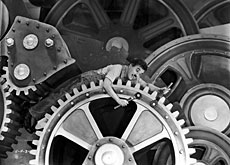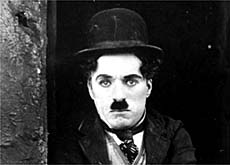Chaplin through the eye of the camera

The magic and genius of Sir Charles Spencer Chaplin has been brought to life through still and moving images at an exhibition at the Elysée Museum in Lausanne.
“Chaplin in Pictures” encompasses more than 250 production stills and studio photographs interspersed with more than 20 screens showing clips from films such as “City Lights” and “Modern Times”.
“It’s a history in pictures of Chaplin as an actor and movie maker, and as a citizen of the world,” chief curator Daniel Girardin told swissinfo. “It is especially interesting to see how he used photography to create and develop the myth of the tramp.”
The evolution of Chaplin’s tramp character from its early incarnation in 1914 as an opportunistic thief through to the big-hearted underdog seen in “The Kid” and “City Lights” is a central theme of the exhibition.
A sequence of a dozen stills along one wall shows the actor striking a variety of poses in his trademark bowler hat, ill-fitting jacket, toothbrush moustache, oversize boots and cane.
In one, a dejected-looking Chaplin stares back at the camera with his hands thrust deep into his pockets; in another, he leans nonchalantly on a straining cane that looks ready to snap.
Such was the success of the character that it spawned an army of imitators. One picture shows scores of Chaplin lookalikes, young and old, outside a cinema showing “The Idle Class”.
In 1925 Chaplin’s lawyers even went before California’s Supreme Court to protect his trademark from plagiarism. Three of the pictures that helped the judges to find in Chaplin’s favour are on show.
Photo and film
Part of the goal of the exhibition is to establish a “dialogue” between still and moving imagery.
In each of the rooms screens project selected extracts and montages from films such as “Shoulder Arms”, “City Lights” and “Modern Times”.
A clip from the last one shows Chaplin mesmerised from tweaking nuts on the factory assembly line. Menacingly armed with a pair of spanners, he gives chase to a lady after becoming fixated with the buttons on her ample chest.
Alongside are shots from the casting for the scene, with four generously bosomed women lining up for the part.
The exhibition also shows the beautifully choreographed boxing scene from “City Lights” and Chaplin behind enemy lines disguised as a tree in “Shoulder Arms”.
For Chaplin’s son, Eugene, who attended the launch of the exhibition, “Chaplin in Pictures” represents more than just a retrospective of his father’s life and work.
“We see the evolution of Charlie Chaplin as he moves through the many different stages of his life,” he told swissinfo. “But there are a lot of pictures here which simply show the history of cinema.”
Swiss sanctuary
For Eugene Chaplin, the fact that the exhibition has finally arrived in Switzerland after spells in Paris, Rotterdam and Hamburg is something extra to celebrate.
Chaplin moved to Switzerland from the United States in 1952, after being accused of “un-American activities” during the era of McCarthyism. He died in Corsier-sur-Vevey 25 years later.
“There were three stages of his life: childhood in England, what I call his turbulent life in the US and then his peaceful life in Switzerland,” added Eugene Chaplin.
A section of the exhibition also charts his father’s influence on the avant-garde movement of the early 20th century.
French painter Fernand Léger is said to have been fascinated by Chaplin, and his 1924 animated film “Ballet Méchanique” opens with cubist pieces of a Chaplin-esque figure swirling around the screen.
Another highlight is a collection of press books kept by the intensely image-conscious Chaplin containing thousands of cutting from newspapers around the world.
“He was very aware of the dissemination of his image and the reaction around the world,” said curator Sam Stourdzé. “The press response influenced him in developing the character of Charlie.”
swissinfo, Adam Beaumont in Lausanne
The exhibition includes more than 250 images from the Chaplin Studios photo archives. It also shows for the first time material from the Keystone album – named after Chaplin’s first production company – tracing the actor’s first 35 short movies.
There are also home movies of the Chaplin family, filmed in colour (8mm), featuring him playing with his children.
The exhibition runs until September 24.
Chaplin was born on April 16, 1889, in London.
He began his career as an actor on the English stage in 1903.
In 1914 he made his first screen appearance.
After being accused of being a communist sympathiser he left the United States for good in 1952 and settled in Switzerland.
He died at his Swiss estate in Corsier-sur-Vevey on December 25, 1977.

In compliance with the JTI standards
More: SWI swissinfo.ch certified by the Journalism Trust Initiative










You can find an overview of ongoing debates with our journalists here . Please join us!
If you want to start a conversation about a topic raised in this article or want to report factual errors, email us at english@swissinfo.ch.